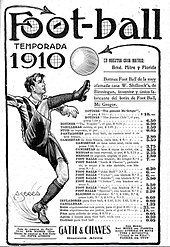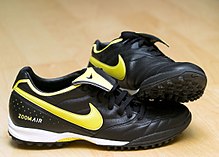This article has multiple issues. Please help improve it or discuss these issues on the talk page. (Learn how and when to remove these messages)
|

Football boots, also known as cleats or soccer shoes in North American English, are a type of shoe worn when playing association football (soccer), most of its variations, and some games that are played on the same surface. Those designed for grass pitches have studs on the outsole to aid grip. Modern football boots are no longer truly traditional boots, as they do not cover the ankle. As with most other types of athletic footwear, their basic design and appearance have converged with those of sneakers since the 1960s.
Football boots, having been developed for association football, are very important in the sport, Some football boots are actually more popular than others some of which are Nike Mercurials and Adidas Predators.
Despite being most associated with football and rugby, the shoe is often used in other sports that are played on grass surfaces, such as touch, lacrosse, hurling, shinty, and tug of war.
History

1800s
During the 19th century, various forms of football became increasingly popular in Great Britain. Participants would wear their heavy and hard work-boots to play. These were the first ever football boots with the steel toe-cap at the front, and they had long laces and were high-topped. These boots also sometimes had metal studs or tacks put on the bottom, so players would have more grip and stability.
In the later part of the 19th century, the first ever football-specific boot was designed, made of thick and heavy leather that ran right to the ankle for increased protection; the first boot weighed 500 grams (18 oz) and would double in weight when it was wet.
1900–1940
During this period, the style of football boots stayed very basic. They remained so during the inter-war years, despite many famous football-boot producers, such as Gola, Hummel, and Valsport becoming ever more popular.
1940–1960
After the Second World War, the designs of the football boot changed dramatically. The South Americans first wore lighter and more flexible boots, which later came to the attention of other nations. This design focused on improving control and kicking-power rather than on a more protective boot. In 1954, Adi Dassler introduced screw-in studs that were used by the German team during a rain-lashed World Cup final that year. (Adi Dassler's older brother, Rudolf Dassler, founder of Puma, disputes the claim that Adi Dassler originated screw-in studs.)
1960s
In the 1960s, many football boots featured a lower cut and were designed to be lighter and more flexible. Mitre, Joma, and Asics joined the fray. Adidas became the top manufacturer during this decade, with 75% of players at the 1966 FIFA World Cup wearing Adidas.
1970s
The 1970s saw many major advances and changes in the design of football boots. These changes included lighter boots and a variety of colours. Boot sponsorship also became more widespread. Adidas was the market leader in this period, releasing new technologies such as padding to provide heel protection. In 1979, Adidas cemented its status by releasing what has gone on to become the best-selling boot of all time, the Copa Mundial. During this time period, some of the most common types of natural leather came into use: kangaroo leather, calfskin and full-grain/cow leather. Diadora entered the market in this decade.
1980s
The 1980s saw further development of the technological advances of the football boot in the 1970s. Umbro, Lotto, and Kelme joined the market in this decade.
1990s
New types of soles were introduced to improve the balance of the player. The Adidas Predator, designed by Australian Craig Johnston in the late 1980s, was released in 1994. Mizuno, Reebok, Uhlsport, and Nike began consistently making football boots in this decade. Nike's first popular boot, the Nike Mercurial Vapor was worn by Ronaldo at the 1998 FIFA World Cup.
2000s
In the first decade of the 21st century, laser technology was introduced to produce the first fully customized football boot in 2006. The first laceless boot, the Lotto Zhero Gravity, was also released in 2006. Laceless boots later became very popular in the late 2010s.
2010s onward
In the era of the modern game that sees the tempo of matches becoming faster and players more technically inclined, manufacturers introduced new technology, including lighter footwear made from alternative materials. Boot customization also became more prominent with the rise of the internet. Laceless boots became very popular after Adidas released the Ace PureControl in 2016. Even though Adidas increased the popularity of laceless boots, the first laceless boots were released by the Italian bootmaker company Lotto in 2006. Despite not being able to make a significant change in the world of laceless shoes, Lotto Zero Gravity was worn by such famous players such as Cafu, Andriy Shevchenko, and Luca Toni. After Adidas started the trend in 2016, other companies like Umbro, New Balance, and Nike have also released their versions of laceless shoes. Laceless boots demonstrate better lock down and lateral stability. A knitted upper allows players to have better ball control due to a larger surface area.
Material for football boots
Football boots are an essential part of a player's equipment. They are designed to provide traction on the field and grip the ground to avoid slipping and sliding. Football boots can be made from many different materials such as rubber, synthetic such as nylon and polyurethane, or leather. The most popular material for football boots is kangaroo leather. Kangaroo leather is a type of leather that is made from the skin of a kangaroo. It has a unique texture, and it is very durable. It is also breathable and lightweight. Some players prefer leather while others like synthetic or plastic material because they are more durable and cheaper.
Different styles for different surfaces

Depending on the type of surface, kind of sport and even the wearer's position or role in the game, different styles of boot and particularly stud configurations are available.
For hard pitches, amateur participants may wear a turf football boot (TF) or a plastic-stud boot (known as a "molded sole"). For indoor football, companies developed indoor court (IC) boots. These come with rubber soles intended to maximize grip on the floor, and are specifically designed for the indoor game. For football on turf or artificial grass, some players wear regular firm ground (FG) football boots. But wearing regular football boots on turf greatly reduces the life of the boot, so companies such as Nike have developed football boots for artificial grass (AG), which have smaller circular studs. The other type of football boot is SG (soft ground). It is recommended to use while playing on well-grassed or sodden field. When playing on this kind of pitch, some players favor using a boot with screw-in studs in their non-dominant (supporting) foot to provide grip, and a boot with short rubber or plastic studs in the dominant (kicking/passing) foot to provide accuracy. However, most players opt for a consistent configuration on both boots.
More recently, molded soles with specially designed boots known as blades have molded soles facing in multiple directions, theoretically to maximise grip and minimize ankle injury. Recently, however, "bladed" football boots have faced criticism from some UK sporting bodies for causing potentially serious injuries to players. English football club Manchester United have even banned their players from wearing boots with bladed studs after players like Wayne Rooney and David Beckham suffered repeated metatarsal injuries.
Questions have been raised about the safety of female footballers wearing men's football boots, mainly due to foot shape and weight distribution differences between women's and men's feet. Despite football boots being unisex, studies have shown that women tend to get injured more often while playing in football boots.
Football markets and brands

Originally, football boots were available only in black, but they are now available in a wide variety of colours. Companies such as Nike, Adidas, Puma have also made an impact on the market. Nike's flagship shoes are the Phantom VNM, Phantom VSN, Tiempos, and The Nike Mercurial Vapor worn by Cristiano Ronaldo and others. German company Adidas are responsible for the Predator range, as worn by David Beckham, Gary Neville, and Steven Gerrard, as well as the long-surviving Copa Mundial. The entire German national side wore Adidas boots during the 2006 FIFA World Cup. German firm Puma's flagship shoes are the Puma King Platinum, Puma Future, and Puma One worn by Sergio Agüero, Marco Reus, Cesc Fàbregas, and Antoine Griezmann.

The Puma King boots have been worn by players, such as Pelé, Eusébio, Johan Cruyff, and Diego Maradona.
In recent times, the most successful companies are Nike and Adidas, and their products are used by professional footballers. Among Nike's endorsers are two-time FIFA World Player of the Year Ronaldinho, Wayne Rooney and Cristiano Ronaldo, Brazilian striker Ronaldo and Zlatan Ibrahimović. Adidas, which has been providing football boots with screw-in studs to the German national football team since the 1954 FIFA World Cup, have signed big name players as endorsers, including players such as David Beckham, former France captain Zinedine Zidane, Frank Lampard, six-time world player of the year Lionel Messi, David Villa, and Steven Gerrard. Puma signed players such as World Cup winners Antoine Griezmann, Marco Reus, Gianluigi Buffon, David Silva, Cesc Fàbregas, Romelu Lukaku, Mario Balotelli and Champions League winner Neymar
| Player | Brand | Figure (per year) |
| Puma | £23m | |
| Nike | £20m | |
| Adidas | £18m | |
| Nike | £15m | |
| Nike | £14m | |
| Puma | £10m | |
| Puma | £5m | |
| Puma | £3.5m | |
| Adidas | £3m | |
| Nike | £2.5m | |
| Adidas | £2.5m |
Customization
Many players use personalization around the world to improve the look of their boots and to make them easily identifiable in the club dressing room. It is now very common to have football boots fully personalized with either a name, initials, number, or club logo. Professional players such as Lionel Messi, Cristiano Ronaldo, and Neymar have all personalized their boots in some way by including their number, the names of their children, or just a flag. The customization process takes place not only to highlight the player's number or initials but also to make boots more comfortable. Shortening a tongue, trimming a hill, rearranging studs, or even using a particular leather has become a common way to increase the comfort level of football boots. One of many examples is English player Declan Rice, who has more than 25 modifications to his AdiPure 11 Pro boots.
See also
References
- "soccer player". Visual Dictionary Online. Merriam-Webster. Retrieved 28 April 2009.
- "Football Boots History". Footy-Boots.com. 9 May 2007. Retrieved 8 June 2023.
the mid-nineteenth century workers were playing football in their hard, leather work boots with steel capped toes, sometimes with leather or tacks hammered into the soles as makeshift studs.
- Goldblatt, David (2006). The History of Football. Penguin Books. ISBN 978-0141026219.
{{cite book}}: Check|isbn=value: checksum (help) - "Football Boots - The 1800s". Footy-Boots.com. 9 May 2007. Retrieved 23 November 2012.
- ^ "Adidas Boots 1960-71". Beyond The Last Man. 3 September 2013. Retrieved 3 November 2020.
- "Football Boots - The 1960s". Footy Boots. 9 May 2007. Retrieved 3 November 2020.
- "Leather vs. Leather?". soccer.com. 29 August 2013. Retrieved 14 October 2013.
- "Launched: First Bespoke football boot". Footy-Boots.com. 11 April 2006. Retrieved 16 March 2011.
- "LOTTO ZHERO GRAVITY". Footy Boots. 7 June 2006. Retrieved 3 November 2020.
- "The Lightest Football Boots You Can Buy in 2020". FOOTY.COM. 27 January 2020.
- "Lotto Zhero Gravity compared to the adidas Ace16+ PureControl". Unisport. Retrieved 3 November 2020.
- Pellatt, Corey (18 January 2016). "adidas Just Revealed the World's First Laceless Football Boot". Complex. Retrieved 3 November 2020.
- "The evolution of laceless soccer cleats: design, market leaders and more | Goal.com US". www.goal.com. 29 March 2023. Retrieved 11 April 2024.
- Pellatt, Corey. "adidas Just Revealed the World's First Laceless Football Boot". Complex. Retrieved 11 April 2024.
- "Soccer Cleats: Best Soccer Shoes For 2022". 20 April 2021. Retrieved 8 April 2022.
- "What Materials are Used in Football (Soccer) Boots?". AZoM.com. 21 November 2012. Retrieved 8 April 2022.
- ^ "Soccer Shoe Guide". Soccer.com. 29 July 2019. Retrieved 15 May 2020.
- "Types of Football Boots Soleplates". top4football.com. Retrieved 11 April 2024.
- "Ferguson wants bladed boots ban". BBC News. 24 September 2005. Retrieved 2 May 2010.
- Okholm Kryger, Katrine; Thomson, Athol; Tang, Alicia; Brown, Nicola; Bruinvels, Georgie; Rosenbloom, Craig; Carmody, Sean; Williamson, Leah; Datson, Naomi; Jobson, Elena; Mehta, Ritan (16 November 2022). "Ten questions in sports engineering: technology in elite women's football". Sports Engineering. 25 (1): 25. doi:10.1007/s12283-022-00384-3. ISSN 1460-2687. PMC 9667860.
- "Nike and Adidas urged by MPs to promote female football boots". 7 August 2023. Retrieved 11 April 2024.
- "Puma Launch their Newest Silo – the Puma EvoPower – In2sports". Archived from the original on 26 April 2015. Retrieved 9 June 2016.
- "PSG star Neymar joins Puma after leaving Nike". ESPN.com. Retrieved 8 April 2024.
- Hepburn, Daniel (3 October 2022). "The 11 players with the biggest boot deals in world football as Trent signs huge Adidas contract". GiveMeSport. Retrieved 16 April 2024.
- "Cristiano Ronaldo Debuts Mercurial Superfly CR7 'Quinto Triunfo'". SoccerBible. 14 December 2017. Retrieved 4 November 2020.
- "Closer Look | Messi Receives Modified Adidas Nemeziz 2018-19 Boots". Footy Headlines. 13 August 2018. Retrieved 4 November 2020.
- James, Stuart. "The secret world of football boots". The New York Times. Retrieved 8 April 2024.
Bibliography
McArthur, Ian; Kemp, Dave (1995). Elegance Borne of Brutality: An eclectic history of the football boot. London: Two Heads Publishing. ISBN 1-897850-76-X.
External links
 Media related to Association football boots at Wikimedia Commons
Media related to Association football boots at Wikimedia Commons
| Association football | |||||||
|---|---|---|---|---|---|---|---|
| Chronology |
|  | |||||
| Rules |
| ||||||
| Equipment | |||||||
| Variants of the game | |||||||
| Positions | |||||||
| Strategy | |||||||
| Skills | |||||||
| Terminology | |||||||
| Memorabilia | |||||||
| Organised supporters | |||||||
| Comparisons | |||||||
| Main associations | |||||||
| Olympic | |||||||
| Lists |
| ||||||
| Related topics | |||||||
| Gridiron football equipment | |
|---|---|
| General | |
| Helmet | |
| Uniforms | |
| Other equipment | |